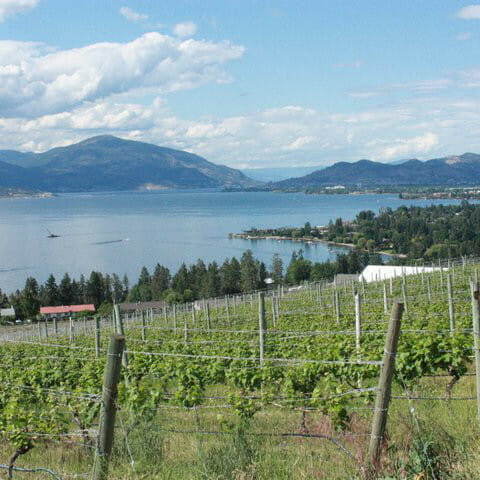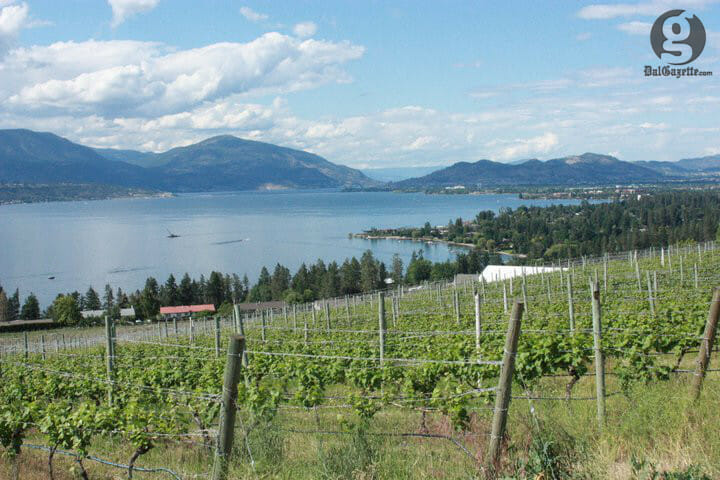
I fell in love with Riesling while I was living in the Okanagan Valley in British Columbia. Well, I guess that’s when I fell deeply in love with wine in general.
The Okanagan Valley is a paradise of fruit orchards and vineyards surrounding a long, narrow lake. The climate is a semi-arid desert with sandy soil. It is a microclimate that grapes love.
Although it is hot in the Okanagan—I hardly ever wore more than cutoff shorts and a bikini top—it wasn’t hot by wine climate standards. That made it ideal for growing Riesling, which tends to fare better in a cool climate.
Rieslings were everywhere in the valley. On my days off from vineyard work I would drive to some of the hundreds of vineyards around the area and taste wines. I’d pack my battered minivan up with friends and road trip through the twisted vineyard roads. I tasted lots of Riesling, and I realized that it wasn’t at all the grape I thought I knew.
When I thought of Riesling I thought of simple, oversweet and wimpy wines. I know better now that I’ve drunk more.
You can find Riesling all over the world, but it is best known in its country of origin, Germany. Riesling is the most planted grape there, and the best come from the Mosel Valley on the banks of the Mosel River.
Other great Rieslings can be found in Austria, the Clare Valley in Australia, in Alsace, France, around the Finger Lakes of New York, in Canada’s Okanagan Valley and in New Zealand.
Riesling has a high natural acidity and low natural sugars, which means it tends to be low in alcohol volume. It can benefit from late-season Botrytis, a welcome form of rot that attacks grapes and concentrates the sugars, making great sweet or dessert wines.
While it is true that Rieslings can be sweeter than other white wines, they compete with the others because they balance their sweetness with high acidity, intriguing aroma and a powerful subtlety.
In a way, Riesling’s tour de force is that it doesn’t have to be abrasive or loud to make you fall in love—it whispers to you.
One distinction you should make when buying Riesling is whether you’d rather a sweet or a dry style Riesling. The drier styles have more potential for aging, so if you see a vintage that’s over two years old, it’s probably going to be dry. One way to know whether it is sweet or dry is to simply read the bottle. When it comes to German wines, it can be more difficult because their labels aren’t often translated for other markets. Either ask the person working at the store, or search the wine on your phone. Most vineyards have websites that will have clear descriptions of their wines, or you can usually find a review with the same information.
With most wines usually the really cheap bottles aren’t that great, but every now and then there’s an exception to the rule. Cost doesn’t necessarily dictate quality. I’ve never had an $8 wine that tasted like gold, but I have had $40 wines that tasted like crap. It’s a bit up in the air.
Riesling, on average, has a pretty low price bracket compared to what you can pay for other white wines. You can get some outstanding Riesling for under $20 and many are around that price range or lower. There are also quite a few in the below $10 price range, but when it comes to Riesling I suggest paying the extra few dollars and the quality will be far above what you’d get with most cheap white wines.
Some dry, aged or complex Rieslings will have pronounced mineral characteristics. A wine that is mineral usually smells or tastes like minerals. This could be anything from granite, to slate, to chalk, to lead. The soil, or lack thereof, in which vines and grapes are grown can have a significant effect on the taste or degree of mineral character in a wine. Riesling is often thought to be very feminine, but I find those that are mineral to be very subtly masculine.
Recently, I was at Gio Restaurant in downtown Halifax, meeting a friend for his birthday, and ordered their Riesling by the glass. It turned out to be outstanding. It was complex and dry, and it got me thinking about Riesling again. I asked the bartender for the bottle and wrote down all the information. Turns out it had won a medal at the Port of Wines Festival in Halifax a few weeks ago.
Next time you’re browsing a drink or wine list, go out of your comfort zone and try something new. Find something you love to drink. I know many students use a few drinks to take the edge off on weekends after a long week at school, but you might as well also enjoy what you’re drinking instead of choking back whatever you saw first on the shelf. The only way to find out is to try, and try again.
—
Dr. Heidemanns-Bergweiler 2010 Riesling
Mosel, Germany $15.99
An almost watery colour with a hint of pale yellow. Quite aromatic. Smelled like my dad painting the fence when I was small, the static of an old projection TV when it gets turned off and a concrete parking garage filled with green apples. On the palate it was much different with notes of honey, apple and apricot. Nice acidity. Perhaps a bit too sweet, but otherwise good balance.
Eat: Would be nice with Gorgonzola or lemon cheesecake.
Listen to: “Self Titled” by Black Dub
My score: 81
—
Southern Sisters – Heath Wines 2006 Riesling
Clare Valley, Australia $24.93
An aromatic wine with some age. On the nose is smelled of petrol, slate, lime, and water that came out of an old schoolhouse drinking fountain with copper pipes. It was dry, with a crisp acidity and medium body. The flavors were apple, citrus and Brazil nut—you know, the big awkward shaped ones that make the inside of your mouth squeaky. Many layers of complexity.
Eat: Raw oysters, seared scallops in garlic or trout.
Listen to: “Phosphene Dream” by The Black Angels
My score: 89







